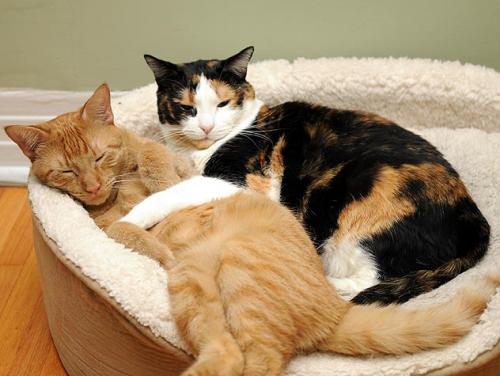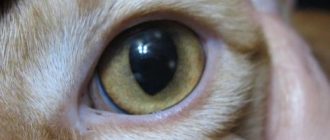Allergy is one of the most common. diseases affecting cats. An allergy occurs when cat’s immune system reacts “too much” to foreign substances called allergens. Allergens are usually just foreign proteins that the immune system is trying to remove out of the body. Too strong a reaction manifests itself in one of three ways:

- The most common allergy symptoms are itching. skin, localized reaction to a specific part of the body, or general reaction throughout the cat’s body.
- Another manifestation affects the respiratory system and may lead to coughing, sneezing and wheezing. Allergies can sometimes result. to discharge from the nose or eyes.
- The third manifestation affects the digestive system, which leads to vomiting, flatulence, or diarrhea.
What types of allergies are there?
Contents
There are four main types of allergies in cats: contact, flea, food and respiratory (atopy). Each species has a basic clinical features and unique characteristics.
What is contact allergy and how to treat it?
Contact allergy is the least common of all The four main types of allergies in cats.
It manifests itself in a local allergic reaction to the skin with contact with an allergenic substance. Examples of such allergies are allergic to shampoo, flea collars, some species litter, for example, of wool, etc. The solution to the problem is removal and prevention of contact with such substances and subjects. However, allergen detection in many cases may be challenging.
How to treat flea allergies?
Flea allergy is the most common type allergies in cats.
Typically, a cat has only slight skin irritation at the site of a flea bite. However, in case of an allergy to flea bites, cats develop severe itching and an allergic reaction to saliva fleas. In some cases, one bite can cause so much severe itching that the cat can seriously scratch and inflict on itself injury, which, among other things, leads to the loss of a large the amount of wool. In the place of the bite, ulcers and scabs, which may result in secondary bacterial skin infection (pyoderma).
The most important part of a flea allergy treatment is prevention of infection by them. Therefore, strict control over fleas is the cornerstone of successful treatment. TO unfortunately this can be challenging in warm and humid climates conditions where a new flea population can hatch every 14-21 day. When strict flea control is not possible, corticosteroid injections are used to help block an allergic reaction and give immediate relief. Fortunately, cats are relatively well resistant to possible side effects from such drugs. If a cat develops secondary bacterial skin infection or allergic dermatitis, then her, most likely, you will need to take antibiotics for a period of two to four weeks.
Airway allergy
Airway allergy or atopy is estimated to take third most common as an allergy in cats. Sometimes it is also called a “seasonal allergy” when an allergen is pollen.
Cats may have the same allergy to tree pollen and plants, like humans. Many cases of such allergies occur. seasonally, however, allergic to mold and other dust may occur at any time of the year. Atopy is also sometimes called hay fever. The cat’s primary reaction to atopy is severe general itching.
Most cats that develop respiratory allergies ways, have several allergens. If the amount of allergens small, then the itching can continue for only a few weeks, once or twice a year. If the quantity allergens is great, or they are present year round, then the cat may itching constantly.
Treatment is highly dependent on the length of the allergic cat season. It consists of one of two approaches:
- The first approach involves the use of corticosteroids and medical shampoos. Steroids block an allergic reaction in most cases and lead to rapid clinical improvement symptoms of a cat. In addition, as indicated earlier, side effects steroids occur in cats much less often than, for example, in dogs or in people. For some cats, hypoallergenic or medical shampoos. It has been proven that some allergens may penetrate through the skin. Regular swimming will reduce the amount allergens and will reduce the possible allergic reaction. In addition to reduce the amount of allergen on the skin, bathing will provide temporary relieve itching and allow lower doses to be used steroids.
- The second allergy treatment approach is to reduce sensitivity to certain allergens. It should not be confused with injections of corticosteroids. The goal of treatment is “reprogram” the reaction of the body’s immune system to allergen. On average, about half of the cats reach a significant reduction of clinical signs of allergies. This approach is usually recommended for adults with old cats that have itching year-round from respiratory allergies. This approach does not used in case of food allergies.
Reducing sensitivity to an allergen as a treatment allergies, has some disadvantages:
- This is the most expensive type of treatment.
- About 50% of cats benefit.
- Duration of treatment: positive results may be received no earlier than 2-5 months.
- The use of steroids can reduce the effectiveness of treatment.
What is food allergy and how to treat it?
Cats are not believed to be born with food allergies.
More often than not, allergies in cats develop to those food products that they have consumed for a long time. Food allergies in cats are currently ranked second by prevalence. Allergic reaction most often develops on a specific protein, such as beef, pork, chicken or turkey. Plant proteins of corn or wheat also may lead to food allergies in some cases. Food allergies lead to itching, digestive upset and respiratory problems. Food allergy testing is done using blood tests or by changing the diet, or switching to special hypoallergenic diet. Allergenic Definition The product usually takes from 8 to 12 weeks.






